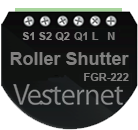IMPORTANT - Read this first!
Note: To simplify these diagrams, we have not shown the earth cables - but all circuits MUST have the earth cable correctly installed.
To protect the module a suitable rated overcurrent protection fuse must be installed on the Live input.
Installing the Fibaro modules involve working with 230V mains wiring. If you are not comfortable doing this you should consult a qualified electrician.
This application note is provided as a guide, all work is carried out at your own risk. Vesternet do not accept any responsibility or liability.
We work hard to keep these wiring guides accurate and up to date and would appreciate any feedback, corrections or suggestions that you may have. Please contact us using our help page or by simply emailing feedback@vesternet.com
This guide shows you how to install the Fibaro Roller Shutter 2 or Fibaro Relay Modules to control curtains, blinds, awnings, garage doors or anything with a motor.
Standard 230V Blind / Motor System
 Figure 1: A standard 230v mains (AC) motor system for blinds or awnings.
Figure 1: A standard 230v mains (AC) motor system for blinds or awnings.
This standard system has a wall switch that controls the motor direction by supplying 230V mains (AC) power to either side of the motors windings.
Installing the Fibaro Roller Shutter
The Fibaro Roller Shutter module is designed to control 230V powered motors, it has two switched contacts that can control the motor's direction (Up/Down). It can be controlled by the local switch or via the Z-Wave network. The module also has a 'learn' feature that you can use to automatically position the blind in your favourite position.
 Figure 2: Installing the Fibaro Roller Shutter module to control a 230V mains (AC) motor.
Figure 2: Installing the Fibaro Roller Shutter module to control a 230V mains (AC) motor.
An additional feature of the Fibaro Roller Shutter is that the two outputs cannot both be active at the same time. In other words, it will not provide power to both Up and Down sides of the motor. This is important as if this happened it would damage the motor and could cause a risk of fire.
Installation for 24V Systems
For low voltage (24V DC) motor systems such as curtain tracks or cinema screens, we suggest using the Fibaro Relay Insert 2 * 1.5 Kw module. This relay has two channels enabling it to control the motor's direction.
Note: You must ensure that you do not activate both the relay's channels at the same time as this will cause power to be applied to both sides of the motor and will cause damage to the motor.
 Figure 3: Installing the Fibaro Relay Insert 2 * 1.5 Kw module into a 24V motor system.
Figure 3: Installing the Fibaro Relay Insert 2 * 1.5 Kw module into a 24V motor system.
Fibaro Roller Shutter 2 Connections
The Fibaro Roller Shutter 2 has six terminals to connect it to the motor wiring:
|
|
Fibaro Roller Shutter 2 Parameter Setting:The following parameters may need to be set:
|
Fibaro Relay Insert 2 * 1.5 Kw Connections
The Fibaro Relay Insert 2 * 1.5 Kw has seven terminals to connect it to the electrical wiring:
|
|
Fibaro Relay Insert 2 * 1.5 Kw Parameter Setting:The following parameters may need to be set:
|
Related Information
- KB-52 - Where to buy blinds
- APNT-73: Somfy Sonesse 40WT (230V)
- APNT-75: Somfy IRS 300 (24V)
- APNT-79: Somfy RTS (wireless)
- APNT-80: Control blinds in VERA based on Environmental conditions
- APNT-83: Control blinds in Fibaro based on Environmental conditions
- APNT-50: Adding Devices in Fibaro Home Center
- APNT-48: Adding Devices to VERA
- APNT-74: Controlling Somfy 24V Blinds with Fibaro Relays











